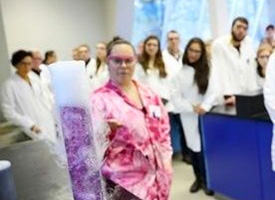On Friday, March 13, Ļķ√Ů≤ ∆Ī announced that in-person instruction was ending for the term. In little more than a week, courses had to be ready to resume via distance ‚ÄĒ representing a huge task for faculty and support staff across the university to move classes large and small alike into an entirely new way of teaching and learning.
Among the largest of all those Ļķ√Ů≤ ∆Ī classes is first-year Chemistry. There are more than 1,050 students enrolled in the course across its various sections ‚ÄĒ amounting to roughly 5 per cent of Dal‚Äôs total student population.
‚ÄúA large class means large diversity as well,‚ÄĚ says Angela Crane, instructor and first-year program coordinator for the Department of Chemistry. ‚ÄúIt means we have a large international population. It means we have students with all sorts of accommodations, for all sorts of reasons. We‚Äôve got single parents in our class.‚ÄĚ
‚ÄúTrying to make something that will work for everyone, to be as universal as possible, has been at the forefront of everything we‚Äôve done leading up to this closure ‚ÄĒ and it really drove our mindset once in-person classes ended and we had to make all these changes.‚ÄĚ
‚ÄúLike a speed race‚ÄĚ
First-year Chemistry at Ļķ√Ů≤ ∆Ī is located in the Faculty of Science ‚ÄĒ Ļķ√Ů≤ ∆Ī's largest faculty in terms of students. The course is based around a common, integrated program called Concepts in Chemistry. Developed by Ļķ√Ů≤ ∆Ī faculty for students roughly 15 years ago, the award-winning program interlinks lectures, textbooks, labs and online content into a unified experience. Still, fundamentally, it's an experience built around in-person engagement. How does one conduct a lab experiment via distance, for example?
The team of faculty, instructors and student TAs who bring Concepts in Chemistry to life each year was already starting to answer questions like that prior to receiving notice that in-person classes were ending for the term. For one, a couple chapters of the program already had to move online due to storm cancellations this winter term. But the team was also watching what was happening down in the United States, where universities began to shut-down in-person instruction a week or two ahead of Canada.  
 ‚ÄúIt was a speed race,‚ÄĚ says Jennifer MacDonald, senior instructor and first-year lab coordinator (pictured in a more traditional lab setting). ‚ÄúWith the labs, we were a bit lucky in that in the experiments that were left, the learning outcomes were based on data interpretation more than hands-on, physical skills. It really helped us make the transition to online a little easier.‚ÄĚ Also helping was the fact that students were able to opt-into virtual assignments prior to in-perso
‚ÄúIt was a speed race,‚ÄĚ says Jennifer MacDonald, senior instructor and first-year lab coordinator (pictured in a more traditional lab setting). ‚ÄúWith the labs, we were a bit lucky in that in the experiments that were left, the learning outcomes were based on data interpretation more than hands-on, physical skills. It really helped us make the transition to online a little easier.‚ÄĚ Also helping was the fact that students were able to opt-into virtual assignments prior to in-perso

